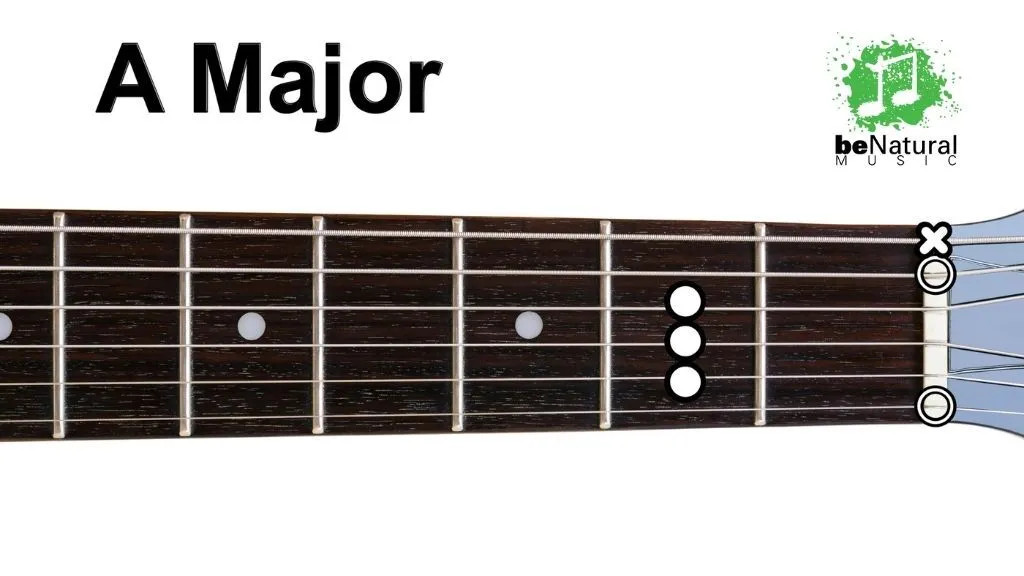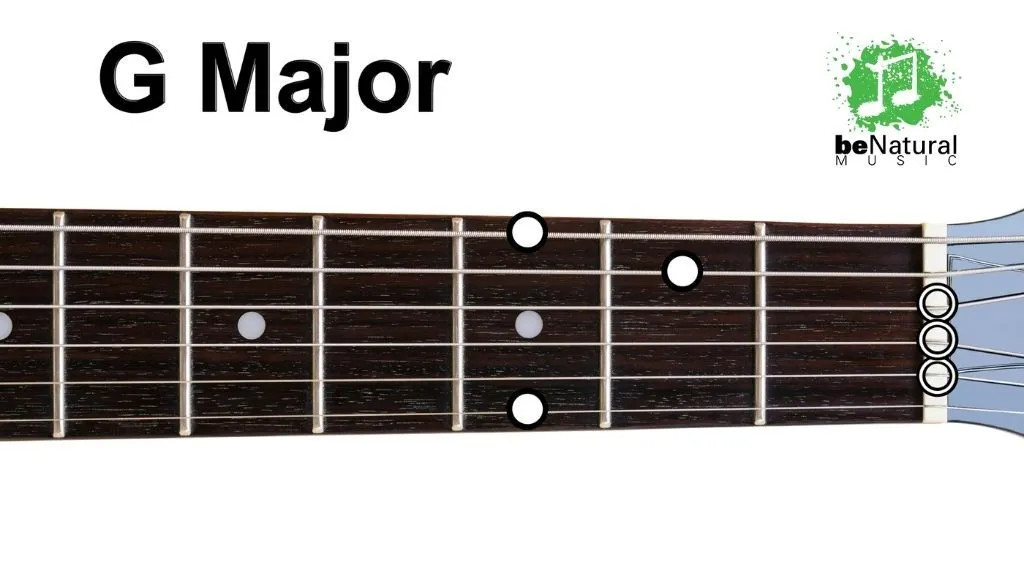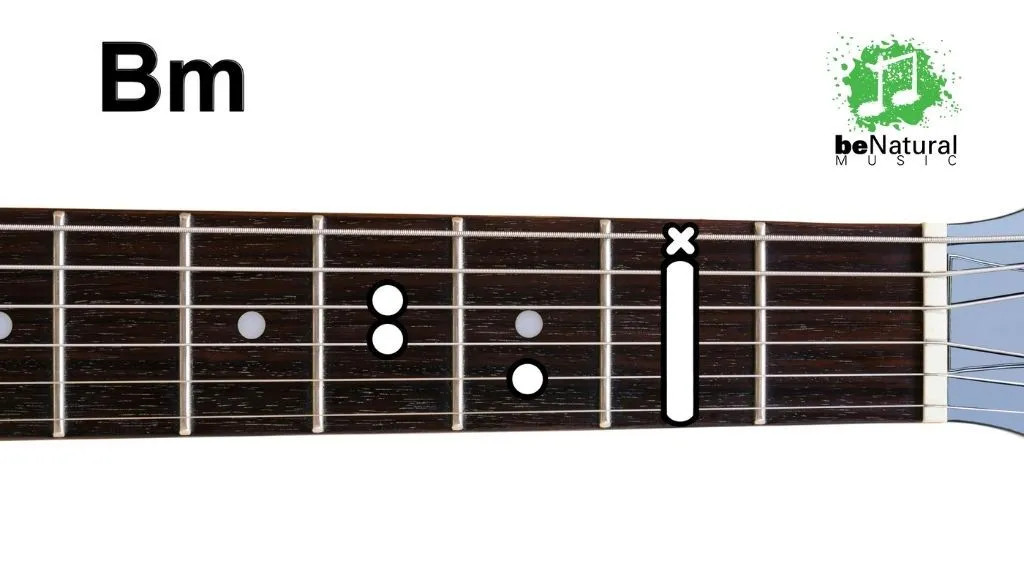Must Know Guitar Chords are your gateway to playing thousands of songs and unlocking your musical potential, and guitarplayers.net is here to guide you. By mastering these foundational chords, you’ll build a solid understanding of music theory and develop the finger strength and dexterity needed to tackle more complex techniques. Let’s explore these essential guitar chords, helping you become a confident guitar player.
1. Understanding Basic Guitar Chord Types
Before diving into specific chords, it’s crucial to understand the three main types of guitar chords. Each type offers a unique sound and plays a different role in music.
1.1 Power Chords
Power chords, the backbone of rock, punk, and metal, are relatively easy to learn. They typically involve only two or three strings/frets, making them less demanding on your fingers. These chords produce a raw, powerful sound, especially when played on electric guitars with distortion.
Power chords are used extensively in rock music. According to research from Guitar World Magazine in June 2023, power chords are foundational for rhythm guitar playing.
1.2 Open Chords
Open chords utilize all the strings of the guitar, creating a full, resonant sound. While they involve fewer frets than bar chords, they require precise finger placement to ensure each string rings clearly. Open chords are an excellent starting point for beginners due to their versatility and widespread use in popular music.
1.3 Bar Chords
Bar chords are more challenging for beginners, as they require pressing down multiple strings with one finger (usually the index finger) across the fretboard. This technique demands significant finger strength and coordination. However, mastering bar chords unlocks access to a wider range of voicings and musical possibilities.
Tips for Playing Bar Chords:
- Ensure each string is evenly pressed down for a clear sound.
- Arch your finger slightly to maximize contact with the strings.
- Practice regularly to build finger strength.
2. How Do You Read Guitar Chord Diagrams?
Chord diagrams provide a visual representation of guitar chords, indicating where to place your fingers on the fretboard. Understanding these diagrams is essential for learning new chords quickly and efficiently.
The vertical lines represent the guitar’s strings, with the leftmost line representing the thickest (low E) string and the rightmost line representing the thinnest (high E) string. The horizontal lines represent the frets. Numbers on the diagram indicate which finger to use:
- Index Finger = 1
- Middle Finger = 2
- Ring Finger = 3
- Pinky = 4
An “x” above a string indicates that the string should not be played, while an “o” indicates that the string should be played open (without pressing down on any fret).
3. What Are The Top 7 Guitar Chords Every Beginner Should Learn?
These seven chords are foundational for playing a wide variety of songs and styles. Mastering them will give you a solid base for further exploration.
3.1 A Major Chord
The A major chord is a fundamental chord that’s relatively easy to form and used in countless songs.
To play the A major chord:
- Place your index finger on the 2nd fret of the D string.
- Place your middle finger on the 2nd fret of the G string.
- Place your ring finger on the 2nd fret of the B string.
- Strum from the fifth string down (avoiding the low E string).
 A major chord diagram
A major chord diagram
3.2 C Major Chord
The C major chord is a versatile chord used in many different genres of music.
To form a C major chord:
- Place your index finger on the 1st fret of the B string.
- Place your middle finger on the 2nd fret of the D string.
- Place your ring finger on the 3rd fret of the A string.
- Strum from the fifth string down (avoiding the low E string).
3.3 D Major Chord
The D major chord has an optimistic sound and is frequently used in pop songs.
To play the D major chord:
- Place your index finger on the 2nd fret of the G string.
- Place your middle finger on the 2nd fret of the E string.
- Place your ring finger on the 3rd fret of the B string.
- Strum from the fourth string down (avoiding the low E and A strings).
3.4 E Major Chord
The E major chord is unique because it uses all six strings, creating a full and powerful sound.
To play the E major chord:
- Place your index finger on the 1st fret of the 3rd string (G string).
- Place your middle finger on the 2nd fret of the 5th string (A string).
- Place your ring finger on the 2nd fret of the 4th string (D string).
- Strum all six strings together.
 E major chord diagram
E major chord diagram
3.5 G Major Chord
The G major chord can be tricky for beginners due to the finger placement, but it’s well worth the effort to learn.
To play the G major chord:
- Place your middle finger on the 2nd fret of the A string.
- Place your index finger on the 2nd fret of the high E string.
- Place your ring finger on the 3rd fret of the low E string.
- Strum all six strings together.
 G major chord diagram
G major chord diagram
Practice switching between G major and other common chords like C or D major.
3.6 A Minor Chord
The A minor chord has a more melancholy sound than A major, often used in ballads and love songs.
To play the A minor chord:
- Place your index finger on the 1st fret of the B string.
- Place your middle finger on the 2nd fret of the D string.
- Place your ring finger on the 2nd fret of the G string.
- Strum from the fifth string down (avoiding the low E string).
3.7 B Minor Chord
B minor is a bar chord, which can be challenging for beginners but is a great chord to start with for learning this technique.
To play the B minor chord:
- Bar your index finger across all six strings at the 2nd fret.
- Place your ring finger on the 4th fret of the D string.
- Place your pinky finger on the 4th fret of the G string.
- Place your middle finger on the 3rd fret of the B string.
- Strum all six strings together.
 B minor chord diagram
B minor chord diagram
4. What Are Power Chords and How Do You Play Them?
Power chords are a simplified type of chord often used in rock and metal music. They consist of only two notes: the root and the fifth. This makes them easy to play and move around the fretboard.
To play a power chord:
- Place your index finger on any fret of the E string (the thickest string).
- Place your ring finger on the same fret of the A string, two frets higher than your index finger.
- Optionally, you can add your pinky finger on the same fret as your ring finger, on the D string.
- Strum only the E and A strings (or the E, A, and D strings if you’re using your pinky).
Power chords are moveable, meaning you can slide the entire shape up and down the fretboard to play different chords. The root note of the chord is determined by the fret you’re playing on the E string.
5. What Are Chord Progressions and How Can You Use Them?
Chord progressions are the foundation of most songs. They are a sequence of chords played in a specific order to create a musical phrase or section. Understanding common chord progressions will help you write your own songs, improvise, and learn new songs more quickly.
Some common chord progressions include:
- I-IV-V (e.g., C-F-G in the key of C)
- I-V-vi-IV (e.g., C-G-Am-F in the key of C)
- ii-V-I (e.g., Dm-G-C in the key of C)
Experiment with different chord progressions to find sounds that you like. Pay attention to the emotional impact of different progressions and how they make you feel.
6. How Can You Improve Your Chord Transitions?
One of the biggest challenges for beginner guitarists is switching between chords smoothly. Here are some tips to help you improve your chord transitions:
- Practice slowly: Start by practicing chord changes at a slow tempo. Focus on accuracy and clean transitions rather than speed.
- Use a metronome: A metronome can help you develop a sense of rhythm and timing. Gradually increase the tempo as you become more comfortable.
- Focus on common finger movements: Identify the fingers that need to move between chords and focus on those movements. Try to anticipate the next chord and pre-position your fingers.
- Practice chord families: Chord families are groups of chords that are closely related and share common finger positions. Practicing chord families can help you develop muscle memory and improve your overall chord vocabulary.
- Use efficient finger placement: Try to use the most efficient fingerings for each chord. This may involve using different fingers than you initially learned.
7. How Does Learning Guitar Chords Help You Learn Songs?
Learning guitar chords is the key to unlocking a vast library of songs. Once you know a few basic chords, you can start playing simple songs and gradually work your way up to more complex pieces.
When learning a new song, start by identifying the chords used in the song. Then, practice the chord changes until you can play them smoothly. Once you have the chords down, you can start working on the rhythm and timing.
8. What Are Some Common Mistakes Beginners Make When Learning Guitar Chords?
Even with the best intentions, beginners often stumble upon common pitfalls when learning guitar chords. Being aware of these can help you avoid frustration and accelerate your progress.
- Not pressing down hard enough: A common issue is not applying enough pressure to the strings, resulting in buzzing or muted notes. Ensure your fingers are firmly pressing down just behind the fret.
- Incorrect finger placement: Even slight variations in finger placement can affect the sound of the chord. Double-check your finger positions against a chord diagram or online resource like guitarplayers.net.
- Not using fingertips: Using the pads of your fingers instead of the tips can mute adjacent strings. Focus on using the very tips of your fingers and arching your hand slightly.
- Rushing the process: Learning guitar chords takes time and patience. Don’t get discouraged if you don’t see results immediately. Consistent practice is key.
- Ignoring finger pain: While some initial discomfort is normal, persistent or sharp pain is a sign to stop and rest. Pushing through pain can lead to injury.
9. What Are Some Exercises to Strengthen Your Fingers for Playing Guitar Chords?
Building finger strength is essential for playing guitar chords comfortably and accurately. Incorporate these exercises into your practice routine to develop the necessary strength and dexterity.
- Finger extensions: Place your hand flat on a table and lift each finger individually, holding the extended position for a few seconds.
- Grip strengtheners: Use a hand grip strengthener or tennis ball to squeeze repeatedly, building overall hand strength.
- Chord practice: Repeatedly practice forming and switching between chords, focusing on applying even pressure to the strings.
- Scales and arpeggios: Playing scales and arpeggios helps develop finger independence and coordination.
- Wrist rotations: Rotate your wrists clockwise and counterclockwise to improve flexibility and prevent strain.
10. What Are the Benefits of Joining a Guitar Community?
Connecting with other guitar players can provide invaluable support, motivation, and learning opportunities. Here are some benefits of joining a guitar community:
- Motivation and encouragement: Sharing your progress and challenges with others can help you stay motivated and overcome obstacles.
- Learning from others: You can learn new techniques, songs, and approaches from more experienced players.
- Feedback and support: Get constructive feedback on your playing and receive support from fellow musicians.
- Jam sessions: Participate in jam sessions to improve your improvisation skills and learn to play with others.
- Networking: Connect with other musicians and potentially form bands or collaborations.
- Discover new music: Explore new genres and artists through recommendations from other guitar players.
Consider joining the guitarplayers.net community to connect with fellow enthusiasts, share your progress, and learn from experienced players.
FAQ Section
What are the easiest guitar chords for beginners?
The easiest guitar chords for beginners are typically E major, A major, D major, and C major. These chords require relatively simple finger placements and are used in many popular songs.
How long does it take to learn basic guitar chords?
With consistent practice, you can learn the basic guitar chords within a few weeks to a few months. The key is to practice regularly and focus on accuracy over speed.
What is the best way to practice guitar chords?
The best way to practice guitar chords is to start slowly, focus on accuracy, and use a metronome to develop a sense of rhythm. Practice chord transitions and try to play simple songs using the chords you’ve learned.
How do I make my guitar chords sound cleaner?
To make your guitar chords sound cleaner, ensure that your fingers are pressing down firmly just behind the fret, using your fingertips. Avoid touching adjacent strings and practice proper strumming technique.
What is a chord progression?
A chord progression is a sequence of chords played in a specific order to create a musical phrase or section. Common chord progressions include I-IV-V and I-V-vi-IV.
How do I find songs that use the chords I know?
You can find songs that use the chords you know by searching online or using chord charts and songbooks. Many websites and apps allow you to search for songs by chord.
Is it better to learn chords or tabs first?
Learning chords first is generally recommended, as it provides a foundation for understanding music theory and harmony. However, some people find it easier to start with tabs, which show you where to place your fingers on the fretboard.
How do I change chords faster?
To change chords faster, practice slowly and focus on efficient finger movements. Anticipate the next chord and pre-position your fingers. Use a metronome to develop a sense of rhythm and timing.
What is a bar chord, and how do I play it?
A bar chord is a guitar chord where one finger is placed across multiple strings on the fretboard. This technique requires significant finger strength and coordination. To play a bar chord, ensure that each string is evenly pressed down for a clear sound.
Where can I find more resources for learning guitar chords?
You can find more resources for learning guitar chords on websites like guitarplayers.net, which offers lessons, chord charts, and tips for beginners. You can also find helpful videos on YouTube and other online platforms.
Ready to Start Your Guitar Journey?
Mastering these must know guitar chords is just the beginning of your musical adventure. Consistent practice, patience, and a passion for music will take you far.
Explore guitarplayers.net for a wealth of resources, including lessons, chord charts, song tutorials, and a vibrant community of fellow guitar enthusiasts. Whether you’re a complete beginner or an experienced player looking to expand your knowledge, guitarplayers.net has something for everyone.
Visit guitarplayers.net today and unlock your full potential as a guitar player. You can also visit us at 1140 Boylston Street, Boston, MA 02215, United States or call us at +1 (617) 747-2261.
